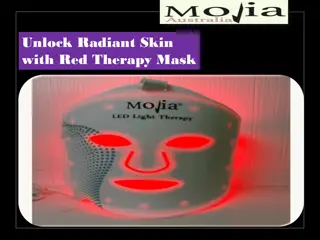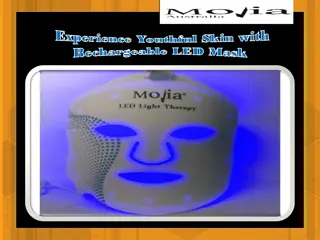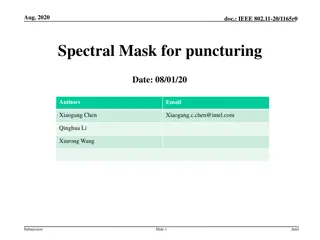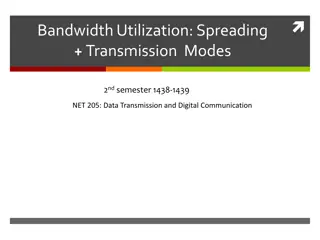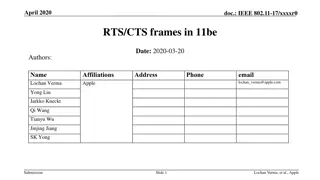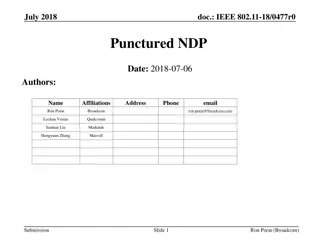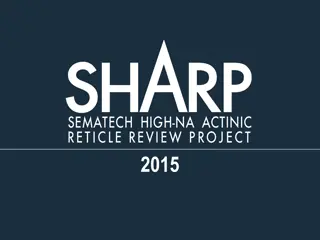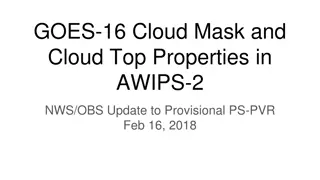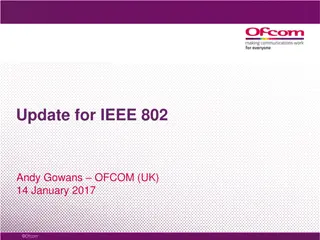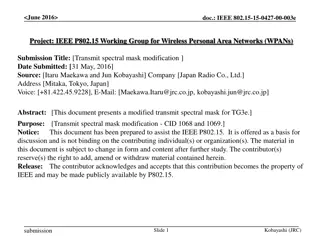Spectrum Mask Requirements in IEEE 802.11 for Punctured Transmission
The document discusses the spectrum mask requirements for punctured transmission in IEEE 802.11 standards, specifically focusing on differences between ETSI and IEEE 802.11ax spectral masks. It covers cases of puncturing scenarios and additional channel edge masks to be applied in different situations. The presentation by Wook Bong Lee from Samsung highlights the essential aspects of multi-RU transmission and preamble puncturing mandatory in the 11be standard.
Download Presentation

Please find below an Image/Link to download the presentation.
The content on the website is provided AS IS for your information and personal use only. It may not be sold, licensed, or shared on other websites without obtaining consent from the author. Download presentation by click this link. If you encounter any issues during the download, it is possible that the publisher has removed the file from their server.
E N D
Presentation Transcript
October 2020 Spectrum Mask Requirement for Punctured Transmission Date: 2020-10-06 doc.: IEEE 802.11-20/1180r1 Authors: Name Affiliations Address Phone email Wook Bong Lee Samsung wookbong.lee@samsung.com Chetan Yadav Samsung c.yadav@samsung.com Submission Slide 1 Wook Bong Lee, Samsung
October 2020 doc.: IEEE 802.11-20/1180r1 Introduction Multi-RU transmission including preamble puncturing is mandatory in 11be Recently, ETSI updated its requirement on punctured channel transmission [1] IEEE 802.11ax spectral mask for punctured case [2] is different from ETSI spectral mask Submission Slide 2 Wook Bong Lee, Samsung
October 2020 doc.: IEEE 802.11-20/1180r1 Without Puncturing: ETSI [1] Submission Slide 3 Wook Bong Lee, Samsung
October 2020 doc.: IEEE 802.11-20/1180r1 Without Puncturing: 11ax [2] Submission Slide 4 Wook Bong Lee, Samsung
October 2020 doc.: IEEE 802.11-20/1180r1 Puncturing Case1: ETSI When the lowest channel(s) and/or the highest channel(s) of a group of adjacent channels is/are unused An additional channel edge mask as in below figure shall be applied at the lower edge of the lowest channel in use and at the higher edge of the highest channel in use. M is the separation in MHz between these 2 channel edges Submission Slide 5 Wook Bong Lee, Samsung
October 2020 doc.: IEEE 802.11-20/1180r1 Puncturing Case1: ETSI When the lowest channel(s) and/or the highest channel(s) of a group of adjacent channels is/are unused An additional channel edge mask as in below figure shall be applied at the lower edge of the lowest channel in use and at the higher edge of the highest channel in use. M is the separation in MHz between these 2 channel edges Submission Slide 6 Wook Bong Lee, Samsung
October 2020 doc.: IEEE 802.11-20/1180r1 Puncturing Case2: ETSI When there are two or more unused channels in between used channels and these unused channels are adjacent to each other An additional channel edge mask as in below figure shall be applied only at the lowest and highest channel edge of the group of unused adjacent channels. U is the total bandwidth of used channels adjacent to the unused channel(s). Submission Slide 7 Wook Bong Lee, Samsung
October 2020 doc.: IEEE 802.11-20/1180r1 Puncturing Case3: ETSI When there is only one unused channel in between used channels (all belonging to the group of adjacent channels configured for multi-channel operation) An additional mask as in below figure shall be applied at both edges of the unused channel. Submission Slide 8 Wook Bong Lee, Samsung
October 2020 doc.: IEEE 802.11-20/1180r1 Puncturing: 11ax For preamble puncture, the signal leakage to the preamble punctured channel from the occupied subchannels shall be less than or equal to 20 dBr (dB relative to the maximum spectral density of the signal) starting 0.5 MHz from the boundary of the preamble punctured channel Submission Slide 9 Wook Bong Lee, Samsung
October 2020 doc.: IEEE 802.11-20/1180r1 Puncturing: 11ax Case 2 and 3 Submission Slide 10 Wook Bong Lee, Samsung
October 2020 doc.: IEEE 802.11-20/1180r1 R1: 320 MHz Non-HT DUP (1/3) Currently, transmit spectral mask for Non-HT DUP is based on 21.3.17.1 (Transmit spectrum mask), which is VHT section Submission Slide 11 Wook Bong Lee, Samsung
October 2020 doc.: IEEE 802.11-20/1180r1 320 MHz Non-HT DUP (2/3) Since there is no transmit spectral mask defined for 320 MHz mask PPDU in VHT, we need to either define Non-HT DUP 320 MHz mask PPDU in EHT or use EHT 320 MHz mask PPDU for Non-HT DUP Comparing with 11ac 160 MHz and 11ax 160 MHz spectral mask, interim transmit spectral mask 0dBr: 11ac 158 MHz vs. 11ax 159 MHz -20 dBr: 11ac 81 MHz vs. 11ax 80.5 MHz -28 dBr: 11ac and 11ax 160 MHz -40 dBr: 11ac and 11ax 240 MHz Submission Slide 12 Wook Bong Lee, Samsung
October 2020 doc.: IEEE 802.11-20/1180r1 320 MHz Non-HT DUP (3/3) Single transmit spectral mask option interim transmit spectral mask 0dBr: 319 MHz -20 dBr: 161 MHz -28 dBr: 320 MHz -40 dBr: 480 MHz Separate transmit spectral mask for Non-HT DUP interim transmit spectral mask 0dBr: 318 MHz -20 dBr: 161 MHz -28 dBr: 320 MHz -40 dBr: 480 MHz Submission Slide 13 Wook Bong Lee, Samsung
October 2020 doc.: IEEE 802.11-20/1180r1 SP #1 Do you support following requirement in 11be? For preamble puncture, the signal leakage to the preamble punctured channel from the occupied subchannels shall be less than or equal to 20 dBr (dB relative to the maximum spectral density of the signal) starting 1 MHz from the boundary of the preamble punctured channel Submission Slide 14 Wook Bong Lee, Samsung
October 2020 doc.: IEEE 802.11-20/1180r1 SP #2 Which option do you support for 320 MHz Non-HT DUP? Single transmit spectral mask option interim transmit spectral mask 0dBr: 319 MHz -20 dBr: 161 MHz -28 dBr: 320 MHz -40 dBr: 480 MHz Separate transmit spectral mask for Non-HT DUP interim transmit spectral mask 0dBr: 318 MHz -20 dBr: 161 MHz -28 dBr: 320 MHz -40 dBr: 480 MHz Submission Slide 15 Wook Bong Lee, Samsung
October 2020 doc.: IEEE 802.11-20/1180r1 Reference [1] ETSI EN 301 893 V2.1.38 (2020-06), 5 GHz RLAN; Harmonised Standard covering the essential requirements of article 3.2 of Directive 2014/53/EU [2] IEEE 802.11ax D6.0 Submission Slide 16 Wook Bong Lee, Samsung




